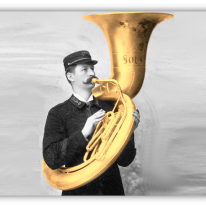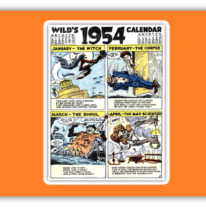A couple episodes ago, I mentioned that opera singers learn to project their voices so people can hear them in the back row of the highest balcony.
That raises the question, how did people in the back rows hear everything before the invention of opera singing? I mean, some of those ancient amphitheaters were pretty big.

Greek actors often wore masks. This wasn’t always the case.
But some of those masks had megaphones built into them.
Simple megaphones are conical tubes, like a funnel in reverse. The sound waves bounce around inside before coming out towards the listener. However, more sophisticated megaphones can have multiple cones inside, and that causes the sound to bounce around even more.

Remember, sound is vibrating air. The more air you can get to vibrate, the louder the sound. Megaphones amplify without electronics.
Let’s fast forward to the late 1800s and early 1900s:
Vaudeville shows were popular. They included acrobats, comedians, jugglers, and, of course, musicians. Some singers used megaphones to project their voices to distant ears.
The most famous of these is Rudy Vallée. His voice was pleasant but not very strong, and he needed all the help he could get to be heard in big venues.

The megaphone became his trademark. However, he may have had mixed feelings about it. Pranksters took to throwing pennies into his megaphone while he was singing.
Radio was another matter. Vallée loved using a microphone. When he sang live on the radio, he could get as close to the mic as he wanted. This closeness gave his voice an implied intimacy, and his love songs became very popular, especially with women.

They followed him everywhere and his concerts almost always sold out. He’s one of our first pop stars.
The microphone made all the difference.
The first recording studios didn’t even use microphones. They had a cone to collect the sound, like a megaphone in reverse. The engineer or producer’s job was limited to placing some instruments closer to the cone than others. Singers would stand off to the side until it was time to sing, then step in front of the cone, sing, and jump out of the way again when they were done.
Volume was crucial to the process. But the equipment, such as it was, couldn’t catch nuances like vibrato or whispering. We think now that they sang in a loud, nasal voice, but maybe they just sounded nasal because the equipment could only pick up the midrange frequencies.

Early microphones had a very small dynamic range.
They could pick up frequencies in the middle, but not high or low ones. That’s why early records sound like the musicians are on a bad phone connection.
That’s all the inventors were trying to do. David Edward Hughes, Emile Berliner, and others wanted to pick up the speaking voice so it could be transmitted long distances. They were interested in communications, not high fidelity, and their early carbon microphones worked as designed.

Later advances, like condenser and dynamic microphones, picked up higher and lower frequencies, and the source sound didn’t have to be as loud. Voices started sounding more natural.
Without these innovations, Rudy Vallée’s thin voice wouldn’t have been a sensation. He didn’t like the word, but his intimate singing style became known as crooning, and the singers were called crooners. As public address systems got better, singers could sound as intimate live as they did on the radio.
Better microphones revealed nuances that audiences couldn’t hear before and that singers couldn’t implement before. Singers learned how to use a mic to their advantage.
Better microphones could reveal mistakes, too. Good singers rose to the top.
Crooning got popular so that bandleaders, who had mostly played instrumentals before, looked for singers.
Sometimes asking their musicians to step up to the mic.
Russ Columbo was a violinist in many bands, and it turned out he had the perfect voice for this new style.

He had many hits and wrote several of them, including his breakthrough, “You Call It Madness (But I Call It Love).”
His popularity led to a good start into movie stardom, but he died in a freak gunshot accident involving an antique dueling pistol. He was 26.
As an aside, Columbo’s mother was in the hospital recovering from a heart attack at the time of his death. The rest of his family worried that the news would cause another heart attack and kill her, so they kept it from her. They didn’t think she would live long, so a little white lie wouldn’t hurt anyone.

With the help of friends, including Columbo’s girlfriend Carole Lombard, they made it seem like he was still alive and doing well.
They told her he was on a five year tour of Europe, forged letters, and used his old records to fake radio programs. This subterfuge continued successfully until the mother’s death.
Ten years later.
One of Colombo’s pallbearers was Bing Crosby.
They had been competitors.

That’s not really true, but their managers cooked up a competition for publicity, planting stories in the press and booking them across town from each other on the same night.
They were actually good friends with similar voices and techniques.
Like Columbo, Crosby had a baritone and an easy way with ballads.

Bandleader Paul Whiteman had hired him and Al Rinker as a duo, but Crosby drank too much.
Whiteman considered firing them after Crosby had a drunk driving accident and spent a little time in jail. Even so, the band had become very popular and their jazz version of “Ol Man River” with Crosby singing lead went to #1.
Crosby’s first solo #1, “Out Of Nowhere,” displays a lot of the old singing techniques, exaggerating vibrato and phrasing. At the start of the third verse, however, the volume drops and he isn’t reaching for the back rows anymore. Singers could now sing to someone near, like a dance partner or a lover. That’s crooning.

He recognized that this was only possible with high quality microphones and amplification. It was the start of his lifelong search for better recording equipment.
Crosby also became known for entertaining troops during World War II. He toured Europe throughout the war. Even the German people came to know him and gave him the nickname “Der Bingle,” which stuck when he got back home.
While in Europe, he discovered that German recording gear was much more advanced than what he had at home. Whether it was him or one of his entourage, someone allegedly stole some equipment and got it back to California. US recording studios improved greatly after that.

As another aside, Crosby recorded many songs with the Les Paul Trio, and he gave Paul an early Ampex reel-to-reel recorder.
Les Paul was an innovator, not only as a musician but as an inventor.
He figured out that by removing the erase head, he could record many times over the same tape without losing earlier takes.
He called this “sound on sound” recording and it allowed him to add multiple guitar and vocal takes to the same song.

She would sing multiple harmony parts.
The couple sold millions of records with what would become called “The Sound.” It would lead to the invention of multi-track recording. Which was invented by Les Paul.
While we know Crosby as a singer and actor, he worked tirelessly to improve recording gear.

In 1961, he and Frank Sinatra used some of their “White Christmas” and “Young At Heart” money to open United Western Recorders, a state of the art studio, in Los Angeles.
As a young man, Sinatra had looked up to Crosby and wanted a similar career in music and movies. At first, though, he had trouble getting noticed. Part of that was he tried to sound like Crosby, but so did everyone else. So he developed his own approach.
There’s a story I can’t verify but it’s a good one so I’ll tell it: He couldn’t read sheet music, but he knew its importance to musicians. He began buying it and keeping his collection up to date with the latest hits. He’d then rent it to bands with the understanding that it came with a singer. He got a lot of his early gigs that way.
He joined a band called The 3 Flashes, though he found out later they only accepted him because he had a car.

They changed their name to the Hoboken Four and did well locally, but the other members weren’t serious about a music career and he moved on.
His fame grew as he jumped from band to band, each more popular than the last: Harry James, Tommy Dorsey, Benny Goodman.
By the end of 1942, he was bigger than Bing. Women and girls mobbed him everywhere he went. A similar thing happened with Beatlemania twenty years later.
Though he couldn’t read sheet music, Sinatra had an innate understanding of how music works. He’d even conduct, and many musicians said he was as good as any trained conductor they had played under.
He also understood how to use a microphone.

He’d get close to it for quiet passages and back away for loud ones. He’d turn his head when singing B or P sounds, as they cause an unpleasant popping sound. Others learned these techniques.
The phrase “The Sinatra Effect” has two meanings. One is used in business and comes from the, “If I can make it there I’ll make it anywhere” line in his song “New York, New York.” It means to show potential clients that you can do for them what you’ve done for others.

The second usage is musical. It means to use his technique of embodying the character in the song the way an actor would.
If the song is from the point of view of a brokenhearted person: sing like your heart is broken.
It’s worth noting here that both Crosby and Sinatra won Oscars for their acting.
Sinatra was tuned in to all kinds of music.
He said Tony Bennett was the best singer in the world, but he called country singer George Jones the second best.

He loved Willie Nelson’s “Stardust” album.
When rock & roll became popular in the late 50s, he didn’t start singing it a la Pat Boone, but he recorded more upbeat material.
Jones and Nelson aren’t known as crooners, but they know you don’t have to sing at top volume all the time.

Jim Reeves is another great example of crooning in country music.
Most of the music mid-century crooners sang over is considered jazz or traditional pop.
Sinatra leaned towards pop. But singers like Nat King Cole were more jazz, with a whole lot of crossover.

I’d bet that Sinatra, Cole, and Reeves could have done admirable versions of the same song in their own genres, each using the Sinatra Effect to make the song their own.
Crooning and high quality microphones had an effect on singers of all genres, from Billie Holiday to Roger Miller, David Byrne to Hope Sandoval to Billie Eilish.
Many singers belt it out.
But crooners have made some of the most beautiful and memorable music of the past one hundred years.
Suggested Listening – Full YouTube Playlist

The One In The World
Rudy Vallée
1929

You Call It Madness (But I Call it Love)
Russ Columbo
1931

Out Of Nowhere
Bing Crosby
1931

Shine On Harvest Moon
Ruth Etting
1931

Do I Worry?
The Ink Spots
1941

I’ll Be Seeing You
Billie Holiday
1944

I Love You For Sentimental Reasons
Nat King Cole
1946

A Man With One Million Dollars
Joe Mooney Quartet
1949

Tell Me So
The Orioles
1949

I See A Million People
Martha Tilton
1950

Smoke Rings
Les Paul & Mary Ford
1952

In The Wee Small Hours Of The Morning
Frank Sinatra
1955

Magic Moments
Perry Como
1958

Are You Sincere?
Andy Williams
1958

I Wanna Be Around
Tony Bennett
1963

I Love You Because
Jim Reeves
1964

Release Me
Engelbert Humperdinck
1967

Stardust
Willie Nelson
1978





Thank you for putting some lovely melodies in my head this Friday morning! I’m embarrassed to admit I missed mt’s lyrical reference in his tease for today’s installment and thought, We’re going to discuss Auto-Tune? (Ay-ay-ay.)
Not today, but I’m sure autotune will come up in future episodes. It’s interesting how technology, whether it’s autotune or new-fangled microphones, affects the music.
Excellent as ever Bill and I know that music is the focus but my take away this week is the way Russ Columbo’s friends and family committed to the subterfuge he was on a never ending tour of Europe. Wow!!
Can’t let Englebert Humperdink pass without referencing the trivia that Release Me deprived Strawberry Fields / Penny Lane of the #1 spot here. Only single between early ’63 and ’69 not to top the charts.
My family did a similar thing for my great-grandaunt. Her son lived several states away, and she knew that they would never see each other again due to health issues for each. When he passed away, his wife continued to write every week (as she had for years) and conveyed his love to her. She never found out that he was gone.
Great reading, and timely, as I am finally starting Bob Stanley’s Let’s Do It: The Birth of Pop. A few pages in and it already mentioned recording tech. being lifted from Germany given its superiority. The more I hear Crosby, the greater appreciation for his talent. Sinatra and Nat are givens and Mad Men introduced me to Gentleman Jim (Welcome To My World), or at least reignited name recognition from the numerous Jim Reeves TV album adverts that played during reruns in the 70s. Perhaps you could take on a follow-up with the Crooners influence from the 50s. Scott Walker and Richard Hawley are faves, but there is an endless list. Cheers!
So Rudy was experiencing the same kind of trouble Bebe Rexha and Drake (books and bras?) are having. What happened to the days when we fans just threw fruit and called it a day?
And now, thanks to Bill, I will immerse myself in The Croon…
Due to an unfortunate scheduling conflict, one of Bill’s Suggested Listening performers was heretofore unable to make it today.
But Artie Kendall is one trooper of a crooner, and has found a way to grace us with his inimitable stylings. Enjoy!
https://www.youtube.com/watch?v=3pT7kBVBEPI
Nice. I guess we’re not in sync this week, but this is directly relevant to what I’m currently trying to write up. Might be a while before it’s actually posted though.
I’m not sure if Al Jolson’s singing technically counts as crooning, but at very least it seems like an important precursor:
https://www.youtube.com/watch?v=Tpe_cqo0z9Q
https://www.youtube.com/watch?v=N8BYsszLzpE
Also, maybe Carlos Gardel? At least when he’s not belting out his choruses.
As for the logical end point of the crooning trend, perhaps whatever it was Neu was doing on this track…
https://www.youtube.com/watch?v=irNQ4LbSgwU
Bing Crosby saw Jolson perform and that made him want to be a singer, too, so, yes exactly, there’s a direct connection. Hadn’t heard that Neu song and, wow, cool. Not crooning exactly but, not far from it and it couldn’t be done without an excellent microphone.
This is Top Shelf stuff – excellent article!!
I was reading along and I got to “The first recording studios didn’t even use microphones” and I could feel my brain starting to work on a dissertation about condensers, ribbons, moving coils, piezoelectricity, and the whole history of microphones for me to post here. I had to stop reading and go outside for a long walk before it went away.
You know I love this kind of stuff, Bill. Thanks for an excellent summary!
https://youtu.be/a4OLBl6SYB4?si=juOXmUfGomdYN4cF
THAT is hilarious.
Boy, that’s swell! Though I’m not convinced that’s crooning.
k.d. lang’s vocal performance on “Constant Craving”: Is that crooning?
When Tony Bennett passed away, I went through his discography and was surprised to learn that he recorded an album with lang.
Hmmm. I think “Constant Craving” comes from the crooning tradition but she sometimes sings in full voice, more like a rock singer. It’s great but I think it’s a step past crooning per se.
Of course, that’s just one dog’s opinion.
My husband and I saw the two of them on tour in the late 1990s in support of that album. It was awesome!